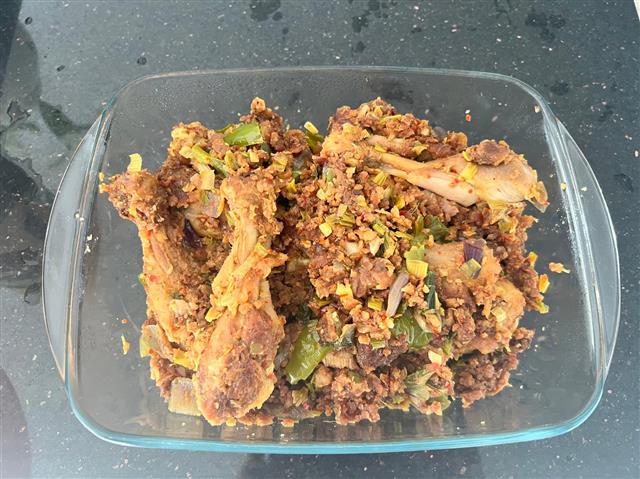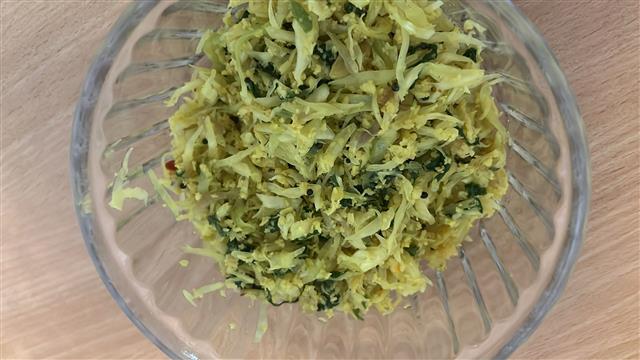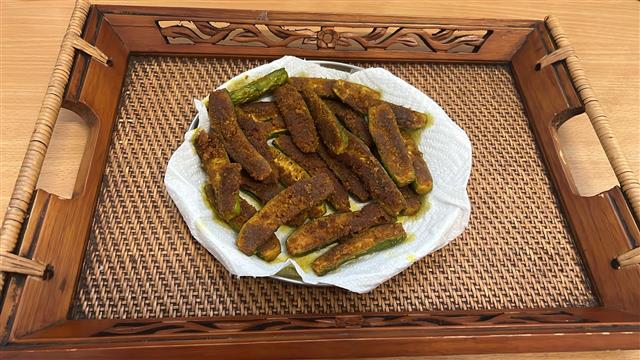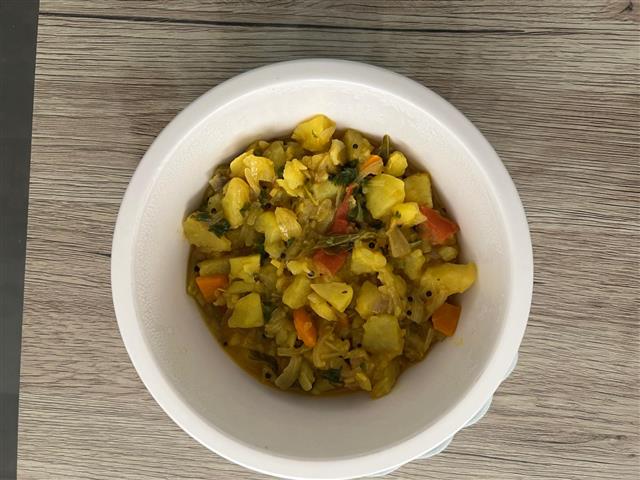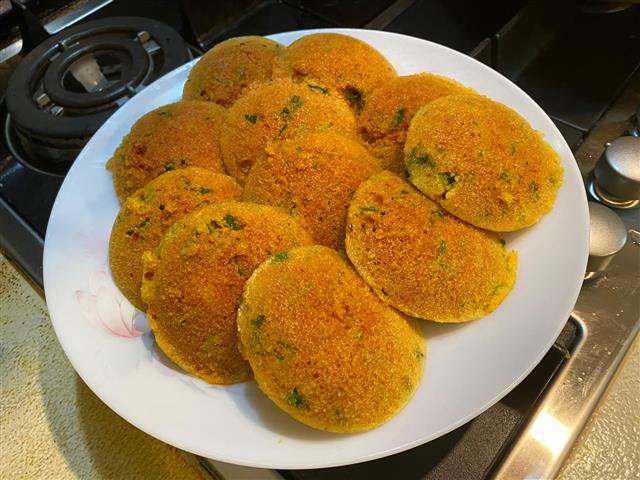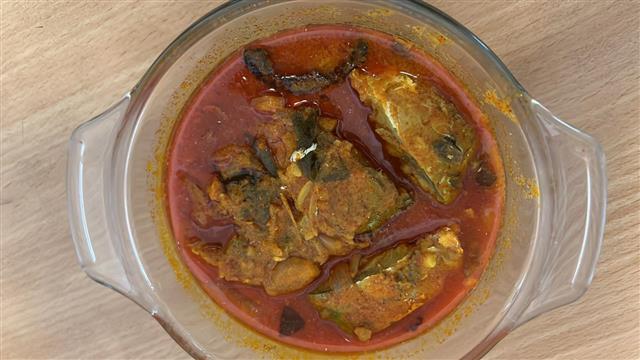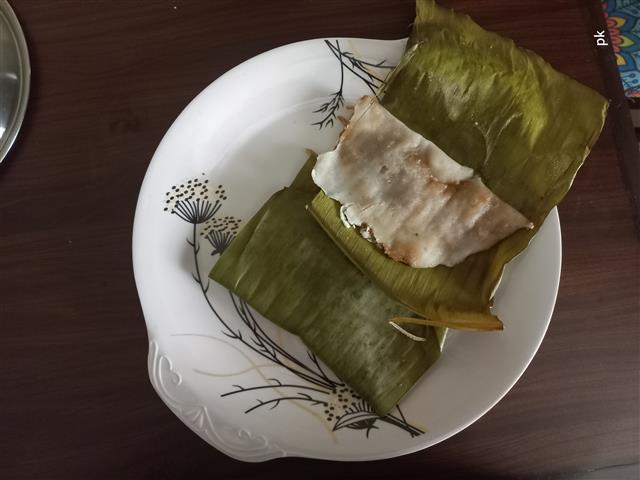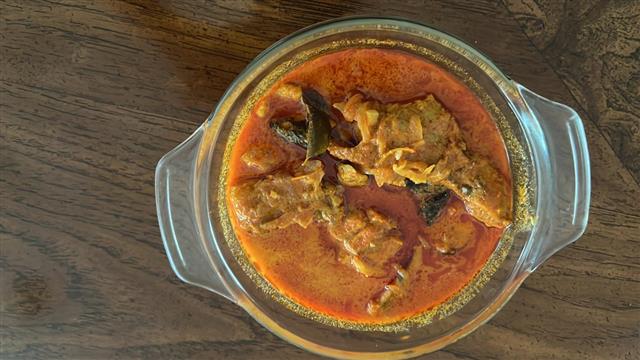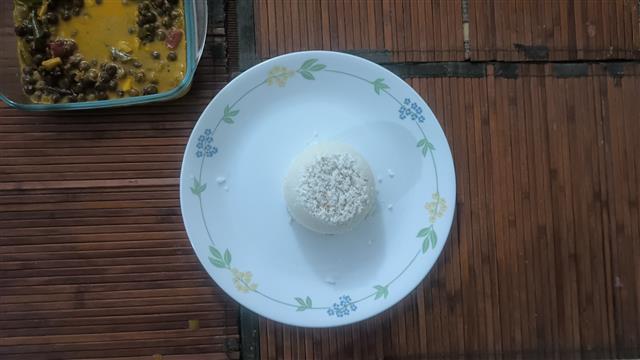
Cherupayar Parippu Curry
(4 reviews)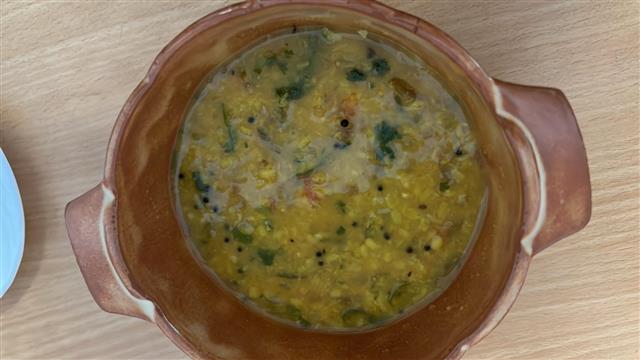
Cherupayar Parippu Curry is a Kerala-style dal made with roasted green gram or moon dal.
It's pressure cooked until soft and then simmered with turmeric and chilli, then a flavourful tempering of mustard, cumin, onions, and tomato.
Perfect for a quick or light meal, and works well as a tiffin box dish
Ingredients
Directions
- Wash the roasted green gram and add it to a vessel with enough water to cover.
- Cook in the pressure cooker water for 1 whistle.
- Open the lid and add turmeric powder, chilli powder and salt. Continuw to cook it well until tender to touch but with a bite.
- In another vessel, heat oil and add mustard seeds, cumin seeds, and green chilli. When seeds splutter, add chopped onion, chopped tomato. and ginger garlic paste,
- Saute for a few minutes. Add the cooked split green gram and boil the curry until well combines. Garnish with coriander leaves
Cooking Tips
• Don't overcook the green gram: It should be tender to touch but retain some crunch. Else it can turn mushy (unless you prefer it this way).
• Adjust chilli to taste: For a spicier version, add more green chilli or red chilli powder. Lower the heat by skipping the green chilli.
• Pressure cooking helps: Just 1 whistle is enough. Overcooking makes it mushy.
• Add tomatoes after the onions: Let onions cook well first for better taste.
• Simmer after tempering: This blends the flavours nicely into the dal.
How to Serve
• With Kanji (rice gruel) for a light meal
• Alongside steamed rice, thoran or fry, and pickle
• With chapati or appam for a quick dinner
• As a protein-rich side in a vegetarian meal
The Story Behind Cherupayar Parippu Curry
Cherupayar Parippu Curry is an easy, everyday dal in Kerala that is enjoyed not just for its taste, but for how versatile and nourishing it is. The reason it's popular with home cooks is that whole green gram cooks faster than most dalsBesides, there is no grinding or soaking of lentils required. Just cook, temper, and serve.
Unlike North Indian dals, Split Moong Parippu Curry is lighter and without the use of heavy spices like garam masala. What makes it different from others? Kerala curries are the noticeable absence of coconut, either as a paste or in grated form.
What is Cherupayar Parippu Curry?
This vegetable curry or dal is light on the stomach and is suitable for all age groups, including toddlers, elders, or those recovering from illness. You simply skip the chillies.
In many homes, especially when preparing a larger quantity, people often combine cherupayar parupu with whole green moong beans or other lentils to balance the texture and add body to the dish. Some modern cooks mix in sprouted moong, which cooks faster and is richer in enzymes. The sprouts add a sweetness and crunch that many enjoy when served with chapati.
Regional Adaptations
Southern Kerala: Sometimes includes coconut milk for a creamier curry. Some even add a touch of fennel seeds in the tempering.
Central Kerala: Often served plain with turmeric, chilli, and a basic onion-tomato tempering, mostly my version.
Malabar: May include roasted coconut paste or ground shallots for more depth and thickness.
Fasting-style: Cooked without garlic and onion. The flavour is lighter, using just green chilli, hing and turmeric.
Ingredient Spotlight
Cherupayar Paruppu (Split Green Gram or Moong Dal)
This lentil is rich in plant-based protein, fibre, B vitamins, and iron. One unique feature is that it's easy to digest. It is also low on the glycemic index, making it a good choice for individuals with diabetes.
Ginger-Garlic Paste
This paste adds to both flavour and health. Ginger supports digestion and has anti-inflammatory benefits, while garlic helps improve immunity and circulation.
Cumin Seeds
Cumin (jeera) adds a smoky flavour to the tempering. In Ayurvedic tradition, it is considered good for digestion and helps ease bloating. It can stimulate appetite in kids.
Pro Tips for Perfect Results
→ Use unpolished cherupayar parippu for better taste and to ensure vitamins and minerals are not lost in processing.
→ Add tempering just before serving to keep the aroma fresh.
→ A pinch of asafoetida (hing) can be added if you like a slightly North Kerala touch.
→ Use shallots or white onion instead of red onion for a sweeter flavour.
Cherupayar Parippu Curry Variations
- With Coconut Milk
Add a splash of milk at the end for a creamy texture.
- Spicier Version
Add crushed black pepper or more green chillies.
- With Curry Leaves
Tempering can Include curry leaves in tempering for aroma.
- With Roasted Coconut
For a more robust version, roast coconut in the tempering.
- With leafy greens or vegetables
Add chopped cheera (amaranth), spinach, or even curry leaves. Add vegetables like carrots, cauliflower, corn or green peas for favour and nutrition.
- No Onion and garlic
For fasting, omit onions and garlic paste, but keep the ginger, and add a pinch of hing (asafoetida).
- Thick Stew Style
Mash the dal partially for a thick, stew-like consistency.
Storing & Reheating Tips
→ Storage: Store leftovers in an airtight container for up to 2 days.
→ Reheat: Gently heat on the stovetop or in the microwave for 1 minute.
→ Freeze: You can drain the cooked cherupayar and store in a freezer-safe container for a couple of weeks. Thaw it the day before you make the curry.
Common Mistakes to Avoid
→ Overcooking in the pressure cooker leads to mushy curry. One whistle and continue cooking on the stove top without lid.
→ Skipping the tempering as the flavour will be flat.
→ Using too much water as it dilutes the taste. You want a curry not a soup.
→ Not sautéing the tomato and onion enough will result n a raw, and uncooked taste.
Frequently Asked Questions
- Can I make it without tomato?
Yes. Add a pinch of asafoetida or dry mango powder for tang.
- Can I skip the onion and ginger-garlic paste?
For a fasting or Jain version, skip the paste and simply add ginger paste or grated ginger. The curry tastes great with the tempering and chilli.
- Is this curry suitable for kids?
Absolutely. Just reduce the chilli and mash slightly before serving.
- Can I use whole green gram or cherupayar instead?
Yes, but it will cook or longer and have a different texture and taste.
Equipment Needed
→ Thick-bottomed kadai or pan
→ Pressure cooker for cooking green gram
→ Ladle or spatula
→ Chopping board and knife
→ Strainer to rinse green gram
